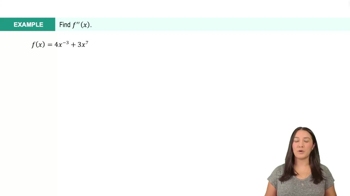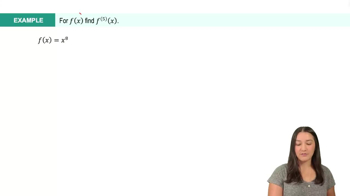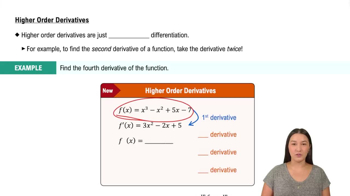Table of contents
- 0. Functions7h 52m
- Introduction to Functions16m
- Piecewise Functions10m
- Properties of Functions9m
- Common Functions1h 8m
- Transformations5m
- Combining Functions27m
- Exponent rules32m
- Exponential Functions28m
- Logarithmic Functions24m
- Properties of Logarithms34m
- Exponential & Logarithmic Equations35m
- Introduction to Trigonometric Functions38m
- Graphs of Trigonometric Functions44m
- Trigonometric Identities47m
- Inverse Trigonometric Functions48m
- 1. Limits and Continuity2h 2m
- 2. Intro to Derivatives1h 33m
- 3. Techniques of Differentiation3h 18m
- 4. Applications of Derivatives2h 38m
- 5. Graphical Applications of Derivatives6h 2m
- 6. Derivatives of Inverse, Exponential, & Logarithmic Functions2h 37m
- 7. Antiderivatives & Indefinite Integrals1h 26m
- 8. Definite Integrals3h 25m
3. Techniques of Differentiation
Higher Order Derivatives
Problem 3.5.79.b
Textbook Question
A differential equation is an equation involving an unknown function and its derivatives. Consider the differential equation y′′(t)+y(t) = 0.
b. Show that y = B cos t satisfies the equation for any constant B.
 Verified step by step guidance
Verified step by step guidance1
Start by substituting y(t) = B cos(t) into the differential equation y''(t) + y(t) = 0.
Calculate the first derivative y'(t) of the function y(t) = B cos(t). This will involve using the derivative of cosine.
Next, calculate the second derivative y''(t) by differentiating y'(t) again.
Substitute both y(t) and y''(t) back into the original differential equation to see if the equation holds true.
Simplify the resulting expression to verify that it equals zero, confirming that y = B cos(t) is indeed a solution.
Recommended similar problem, with video answer:
 Verified Solution
Verified SolutionThis video solution was recommended by our tutors as helpful for the problem above
Video duration:
11mPlay a video:
Was this helpful?

 2:42m
2:42mWatch next
Master Higher Order Derivatives with a bite sized video explanation from Callie
Start learningRelated Videos
Related Practice




